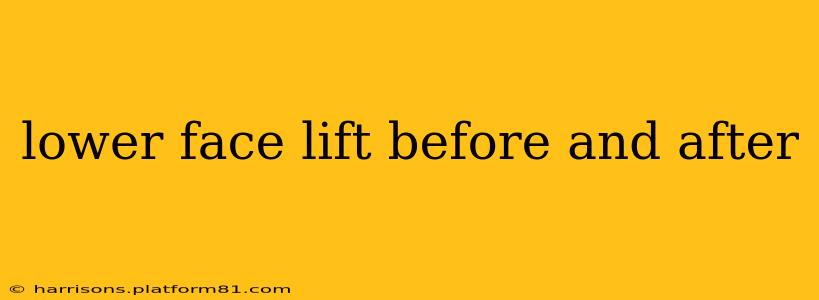A lower face lift, also known as a lower rhytidectomy, is a surgical procedure designed to rejuvenate the lower third of the face, addressing sagging skin, jowls, and loss of definition in the jawline and neck. Many people are curious about the transformative results, prompting searches for "lower face lift before and after" photos. While these visual representations are helpful, understanding the procedure's intricacies, recovery process, and potential risks is crucial before making a decision. This comprehensive guide delves into all aspects of a lower face lift, answering frequently asked questions and providing you with the information you need to make an informed choice.
What Does a Lower Face Lift Involve?
A lower face lift targets the areas below the cheekbones, focusing on lifting and tightening the skin, underlying tissues, and muscles of the lower face and neck. The surgeon makes incisions, usually concealed within the hairline and around the ear, to access and reposition the tissues. This process addresses sagging skin, defines the jawline, and improves the appearance of jowls and neck bands. The specific techniques employed can vary depending on the individual's needs and the surgeon's preference. Some procedures might incorporate liposuction to remove excess fat, further refining the contours of the face and neck.
How Long Do Lower Face Lift Results Last?
The longevity of a lower face lift's results varies depending on factors such as individual aging processes, lifestyle, sun exposure, and genetics. While the procedure doesn't halt the natural aging process, it can significantly delay its visible effects. Most patients enjoy noticeable improvements for several years, often seeing results last for 5-10 years or even longer. Maintaining a healthy lifestyle and protecting your skin from sun damage can help prolong the results.
What is the Recovery Time for a Lower Face Lift?
Recovery after a lower face lift typically involves some swelling, bruising, and discomfort in the initial days. Pain management is usually achieved with prescribed medication. Most patients require about 1-2 weeks of downtime before returning to work or social activities. Stitches are typically removed within a week. Full recovery, including the dissipation of swelling and bruising, may take several weeks or even months. Regular follow-up appointments with the surgeon are essential to monitor healing progress and address any concerns.
What are the Risks and Complications Associated with a Lower Face Lift?
Like any surgical procedure, a lower face lift carries potential risks and complications. These can include, but are not limited to:
- Infection: As with any surgery, there's a risk of infection at the incision sites.
- Hematoma: This is a collection of blood under the skin, which can cause swelling and discoloration.
- Nerve damage: Temporary or, in rare cases, permanent nerve damage can affect facial sensation or muscle movement.
- Scarring: While incisions are strategically placed to minimize visibility, some scarring is inevitable.
- Asymmetry: Slight asymmetry in the facial features may occur.
- Unsatisfactory results: Individual results can vary, and it's important to have realistic expectations.
It's crucial to discuss these risks thoroughly with your surgeon before undergoing the procedure.
What is the Difference Between a Lower Face Lift and a Neck Lift?
A lower face lift primarily focuses on the lower face, addressing jowls, and improving the jawline. A neck lift specifically targets the neck, tightening the platysma muscle (the muscle that runs down the front of the neck) and removing excess skin to improve the neck's appearance. Often, a combination of both procedures, sometimes called a "face and neck lift," provides the most comprehensive rejuvenation.
How Much Does a Lower Face Lift Cost?
The cost of a lower face lift can vary significantly depending on several factors, including the surgeon's fees, the location of the practice, the complexity of the procedure, and any additional procedures required. It's best to schedule a consultation with a qualified plastic surgeon to receive a personalized cost estimate.
How Can I Find a Qualified Plastic Surgeon for a Lower Face Lift?
Choosing a qualified and experienced plastic surgeon is paramount. Look for board-certified plastic surgeons with extensive experience in performing lower face lifts. Review their before-and-after photos, read patient testimonials, and schedule consultations to discuss your goals and assess their expertise and comfort level with your case. Remember, choosing the right surgeon is a critical step in achieving successful and safe results.
This information is for educational purposes only and does not constitute medical advice. Always consult with a qualified healthcare professional for any health concerns or before making any decisions related to your health or treatment.
